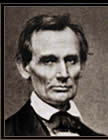This paper, reprinted with the kind permission of the American Medical Association, appeared in the April 1952, Volume 67, Number 4 edition of the A.M.A. Archives of Neurology and Psychiatry, Pages 419-433. (Copyright 1952, American Medical Association)
by Edward J. Kempf, M.D. Wading River, N.Y.
- Introduction
- Hereditary Determination
- Hypokinetic Constitution
- Lincoln's Face
- Fracture of Skull and Injury of Brain in Boyhood
- Tentative Diagnosis of Nature of Cerebral Injury
- Diplopia and Astigmatism
- Practical Adaptation to Gloomy Eyestrain
- Enigmatical Expression
- Superstitious Interpretation of Diplopia
- Preference for Photographs of Right Side of Face
- Vicious Circle of Organic and Emotional Neuroses
- References
INtroduction
The physical constitution of Abraham Lincoln has perplexed his biographers and portrait sculptors and painters, as it did his personal friends, because of certain enigmatical qualities in his face and personality. More books, articles, and speeches are said to be presented yearly on Lincoln than on any man in history, and his philosophy of democratic government of the people, by the people, and for the people has become the philosophy of the democratic political organization of the United Nations, as well as the United States. It is therefore important that any new evidence on his physical constitution and neuroses that would be helpful in understanding his personality should be published.
The following discussion presents a new consideration of the evidence on his genetic and endocrine constitution, followed by a new, recently discovered evidence of an accidental fracture of his skull in childhood from the kick of a horse. This fracture left certain permanent injuries and functional impairments of his brain that greatly influenced the schizoid, melancholic-euphoric development of his personality and thereby his marital life and legal and political career.
next -->
